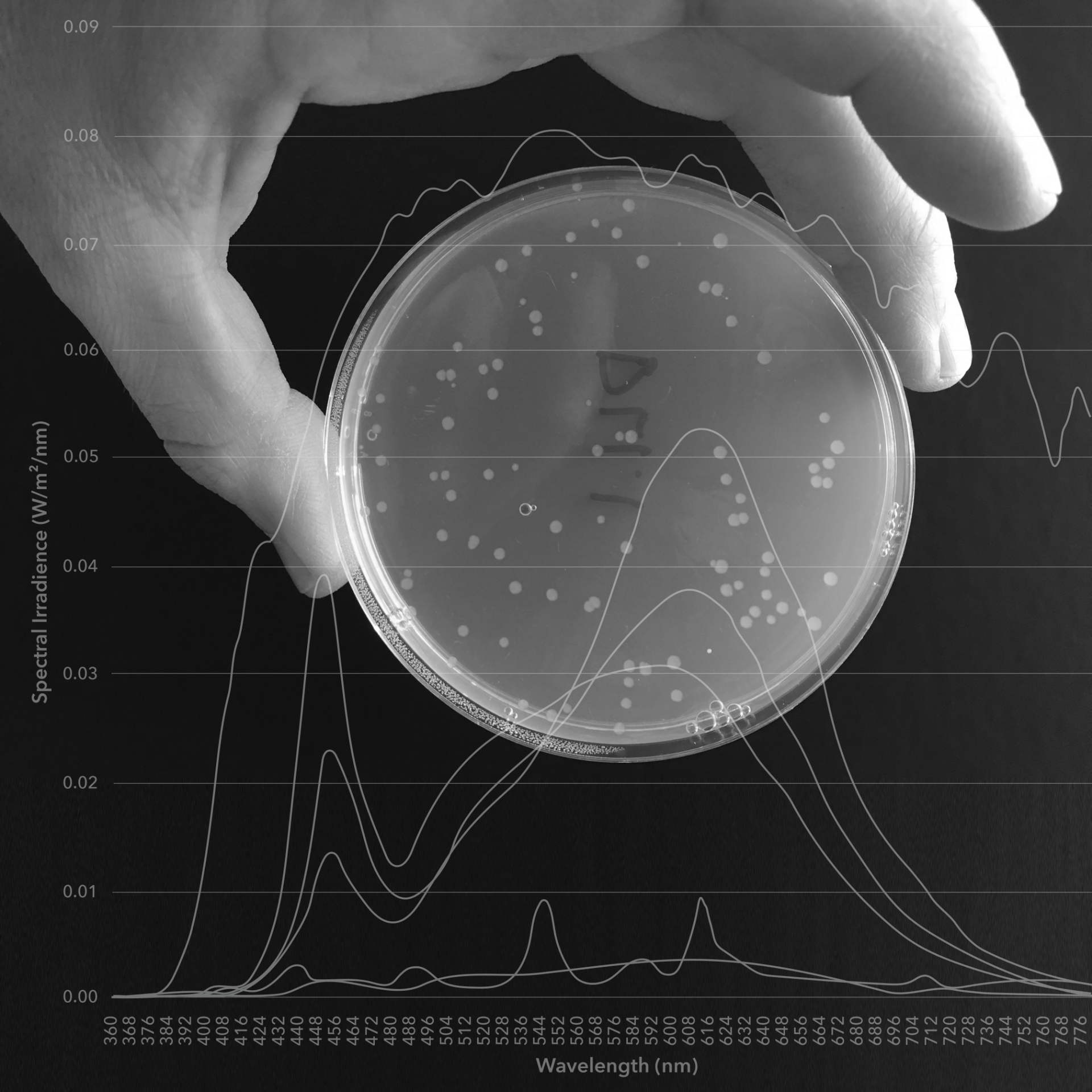01 Light + MICROBES COLUMN
Daylight exposure modulates bacterial communities associated with household dust
Daylight is elemental to architecture and life on earth. Humans have evolved outdoors with daylight in a co-existence with single-celled organisms such as bacteria. But how does daylight affect communities of bacteria in human-constructed new habitats, such as indoor built environments? To better understand this question, we isolated homogenized house dust inside self-contained “microcosms” (sealed architectural models scaled down with typical room dimensions and window sizes) and subjected the dust samples to 90 days of 1) darkness, 2) the visible portion of the daylight spectrum, or 3) only the UV portion of the daylight spectrum. Substantial numbers of viable bacterial cells were still recovered from the dust samples after three months without additional microbial colonization from human or environmental sources, and without further addition of nutrients.
Total living bacterial biomass at the end of the study was lower in dust that received any light treatment (UV or visible) than dust in the dark. Moreover, dust exposed to light contained a greater proportion of outdoor-associated bacteria than the dust in the dark microcosms, which contained more human-associated bacteria. These findings provide modern scientific support for the adage, “30 years in the dark but 30 seconds in the sun” (referring to survival of Mycobacterium tuberculosis) and suggest that further investigation of the impacts of natural and electric lighting on potential pathogens inside buildings is warranted. (Fahimipour, et al. 2018)
Introducing daylight indoors reduces the viability of pathogens on surfaces and in air
What impact might daylight have on pathogens indoors? To understand the intersection of lighting patterns and indoor pathogen viability impacting human health, we used a simulation approach that draws on what we know about air dispersion, settlement of droplets and aerosols onto common indoor surfaces like desktops and exposing them to natural sunlight as a function of glazing property, light spectrum, light intensity, and exposure duration. These variables are simulated with the Radiance suite of daylighting simulation tools.
A key piece to this approach is obtaining site-specific, spectrally resolved solar radiation data. These data are required to derive the sky’s direct and diffuse properties while indoor material samples are physically tested to determine their reflectance properties. These properties are then applied to the digital Radiance model to simulate specific wavelengths of indoor visible light and UVB wavelengths. Radiance simply performs raytracing calculations based on the material and light source definitions. As such, it gives us the flexibility to adjust the inputs depending on desired outputs. The simulated indoor UVB intensity is then used to calculate and visualize the rate of surface viral degradation via a minute-by-minute 3D heat map. We have now developed and tested this simulation workflow and are currently focusing on digital modeling to iterate visible and UVB-based viral degradation across model geometry, orientation, location, and sky conditions. In the above image, you will note the spheres in the room that spatially depict viability (based on saturation intensity) of SARS-CoV-2 in response to light coming through open windows and skylight in a residential setting.
Do bacteria have circadian rhythm modulated by built environment lighting?
Research has established that changes in the environment around microbes leads to changes in the overall composition of the microbial communities. But very little research exists on how the lighting environment affects the microbes of the built environment. Artificial lighting has been used widely to stimulate photosynthesis in plants indoors, even so far as to provide spectral lighting personalized to the needs of individual plant species, and it is possible that artificial lighting in the built environment might facilitate photosynthesis in microorganisms as well.
Most built environments, including office buildings, schools, hospitals, retail, and certain locations within residential buildings maintain constant lighting during the day and often through the night. Artificial light at night (ALAN) breaks the typical diurnal cycle and has already been shown to have effects on humans and animals. Similarly, preliminary investigations into microbes have hinted that ALAN may also impact the typical behavior of microbial communities, though most specifics remain unknown.
The Biology and the Built Environment Center is currently collaborating with the Eisen Lab at UC Davis Genomics Center to investigate the role of electric lighting and ALAN on the activity of the unseen occupants in our indoor built environments: bacteria.
Do built environment indoor lighting patterns influence how bacteria express their characteristics?
Since 1845, a large body of research has been conducted on the effect of full-spectrum daylight, ultraviolet light, and other wavelengths on mono-cultured bacterial survival and activity. There has also been a great deal of work on the effect of light and architectural design to improve health and comfort. In addition to human health, recent research from the BioBE Center has demonstrated that daylight can decrease the overall abundance of bacterial communities and influence the composition in indoor household dust.

Yet, in addition to potentially inactivating or sterilizing certain microorganisms, light can be a source of energy. For example, there are at least seven phyla of bacteria and multiple lineages of microbial eukaryotes that have been shown to even perform photosynthesis (fixation of carbon driven by using the energy from light).
By isolating our mock microbial communities in microcosms and using different electric lighting schemes independently of one another, we seek to gain an understanding of the rules and mechanisms that govern why some microbes of the built environment community persist while others perish. We seek to identify causal relationships between built environment design and microbial community composition, dynamics, succession, resilience, and adaptability. This serves as a first step towards being able to accurately predict and manipulate built environment microbiomes in a safe and sustainable way.

